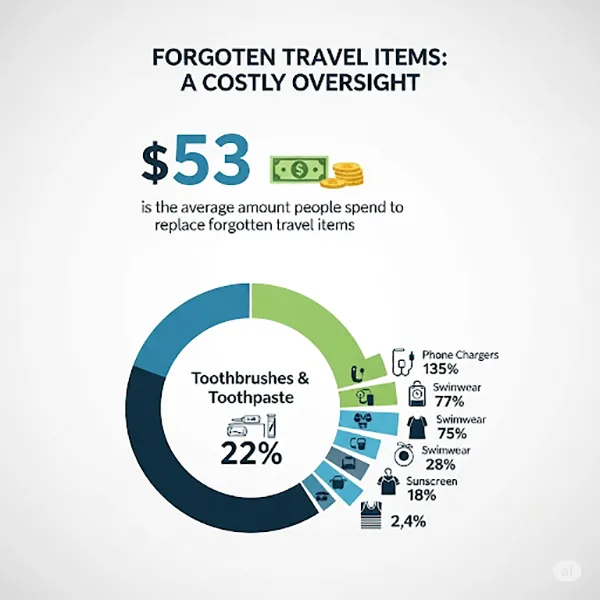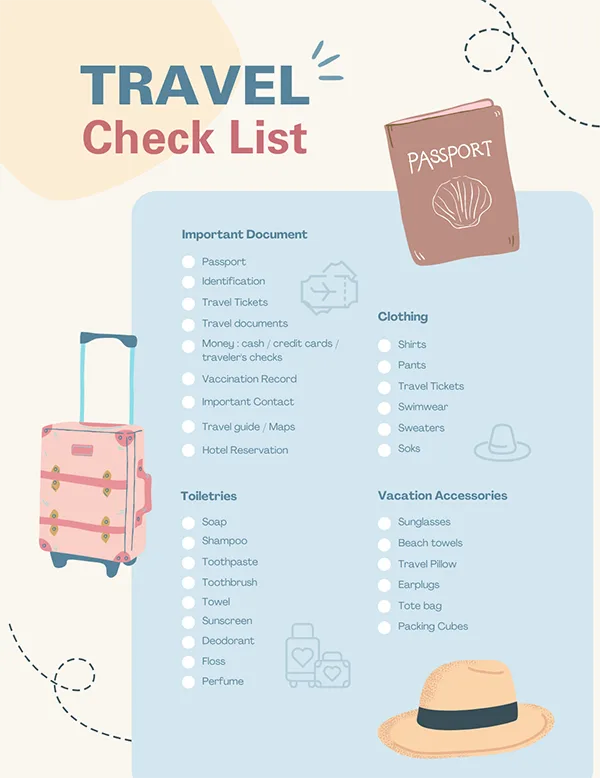
The excitement of travel is often accompanied by a quiet sense of dread—the fear of forgetting something important. This isn’t just a minor inconvenience; it’s a common and frustrating reality for many.
According to a Talker Research survey of 2,000 U.S. adults, nine in ten Americans have experienced a “Home Alone” moment, realizing they’ve left behind an essential item on their way to a destination.
Forgetting things like phone chargers (34%), toiletries (32%), or even medication (18%) can turn a smooth journey into a scramble to replace items, negatively impacting the trip for over 42% of travelers.
To help you avoid these last-minute stresses, this guide offers a comprehensive, systematic approach to a pre-travel checklist, ensuring your focus remains on the adventure ahead, not on what you left behind.
KEY TAKEAWAYS
- Check your passport’s expiration date at least six months in advance and apply for any necessary visas well before your trip.
- Avoid expensive roaming charges with an international eSIM card, which can be activated instantly and offers more flexibility than traditional physical SIM cards.
- Use the weather forecast as a guide, but pack versatile, mix-and-match layers. Don’t forget essential gadgets like a portable battery pack and universal adapters.
- Before you leave, remember to prepare your home by stopping mail delivery, arranging for a pet/plant caretaker, and cleaning out the refrigerator.
- Notify your bank of your travel plans and create physical and digital backup copies of your important documents, storing them separately from the originals.
Essential Travel Documents and Preparation
It should be your priority to get your documentation sorted when planning any trip. Since many countries require that your passport have at least six months left on it, you should check the dates of expiration well in advance.
Passport and Visa Requirements
Commence by identifying your passport’s expiration date. In case it’s expiring within the next year, think of renewing it now. When you’re ready to travel, you don’t want to be held up waiting for a new passport because processing times can vary greatly.
Visa requirements for your destination country can take weeks or even months to process, so don’t leave this until the last minute. Many countries now give e-visas, which can speed up the process considerably.
Travel Insurance and Emergency Contacts
Travel insurance can be valuable for domestic travel. Look for policies that cover trip cancellations, medical emergencies, and lost baggage. To find out what is covered, read the fine print.
Make an account for emergency contacts, including your insurance bank, provider, and someone back home who can offer help if needed. Store both digitally and on paper.
Connectivity Planning for Modern Travelers
Staying connected while traveling has been critical for most people. Whether you need to use maps, check emails, or stay in touch with family, having trustworthy internet access can make or break your trip.
International Connectivity Solutions
Traditional roaming charges can be expensive and unreliable for international travel. Many travelers are now becoming the best esim for asia and other regions due to convenience and cost savings. These digital SIM cards can be activated instantly and don’t need to be physically swapped.
Compared to traditional SIM cards, an international eSIM card offers several advantages. To save yourself the trouble of locating a nearby provider when you get there, you can buy and activate them before you leave home. They’re mainly useful for multinational trips where you’d otherwise need multiple physical SIM cards.
Understanding How Digital SIM Cards Work
In the digital age, you might be curious how international SIM cards work. Unlike traditional SIM cards that must undergo physical insertion into your phone, eSIMs are embedded directly into your device. To connect to local networks, just enter activation information or scan a QR code.
You may see travel SIM cards in both physical and digital formats. In contrast to eSIMs, which are activated via software, physical cards must be placed into your phone. Both offer access to local cellular networks, but eSIMs give more flexibility and convenience.
Avoiding Common Connectivity Issues
eSIM activation challenges can occasionally arise, but they’re often easy to resolve. Although the majority of modern smartphones support eSIM, it’s a good idea to review your device’s specs.
The benefits of eSIM cards extend far beyond convenience. They can be controlled completely through your phone’s settings, usually have lower costs than traditional roaming, and let you keep your home number when using local data. This technology is mainly valuable for frequent travelers who need trustworthy connectivity across multiple countries.
Packing Essentials That Matter
The goal of smart packing is to pack only what you need, leaving space for unforeseen purchases and souvenirs, rather than packing everything into your suitcase.
Clothing Strategy
You should check the weather forecast for your destination, but don’t completely rely on it. Even if you’re traveling to a tropical location, always bring one warm item and layers that can be combined. Air conditioning can be freezing, and the weather can change quickly.
Go for versatile pieces that can be dressed up or down. For example, a simple dress or nice shirt can give warmth in both casual sightseeing and dinner out. To make everything coordinate, stick to a color scheme that complements one another.
Technology and Gadgets
Consider what technology will improve your trip, beyond your phone and charger. It’s almost always worth the extra room to have a portable battery pack, particularly if you’ll be using your phone a lot for photos and navigation.
Don’t forget the right adapters suited for your destination. Most nations can use universal adapters, but some have special outlets that call for particular adapters. Research this before you go, instead of hunting for adapters when you arrive.
INTERESTING FACT
People spend an average of $53 to replace items they forgot to pack when on a trip. The most commonly forgotten items are toothbrushes and toothpaste, with 22% of travelers admitting to leaving them behind at least once.

Last-Minute Preparations
The final days before your trip are crucial for ensuring everything goes smoothly. This is when you’ll handle the tasks that can’t be done too far in advance.
Home Preparation
Ask a reliable neighbor to watch over your property and pick up any packages that may arrive, and stop mail delivery if you will be gone for more than a few days. If you have pets or plants, ensure your caretaker has clear instructions and emergency contacts.
Take out the waste materials and clean out your refrigerator of perishables. Nothing is worse than discovering spoiled food and disagreeable smells when you get home. Set your room temperature to save energy while you’re away, but don’t make it so extreme that pipes may freeze or plants could suffer.
Final Documentation Check
Print backup copies of important documents like your driver’s license, passport, and travel insurance. Store these aside from the originals. You can access these documents from anywhere by taking pictures of them and storing them in cloud storage.
Notify your bank and credit card providers about your travel dates and destinations. This keeps your purchases from being reported as suspicious. It’s the most disappointing thing to have your card declined when you’re attempting to pay for dinner in a foreign country.
Double-check that you have everything on your list the night before departure. Pack any last-minute items, such as chargers and toiletries, and arrange your travel attire. Verify that you have downloaded any offline maps or travel apps you may require and that your phone is fully charged.

What’s the most commonly forgotten travel item?
Phone chargers and adapters are frequently forgotten, followed by prescription medications and comfortable walking shoes for the destination climate.
Do I need travel insurance for short trips?
Yes, even short trips can involve unexpected medical expenses, flight cancellations, or lost luggage that travel insurance can cover.
What should I do if I forget something important while traveling?
Don’t panic – most items can be purchased at your destination, though they might cost more than at home.
Final Thoughts on Travel Preparation
Being well-organized to manage any situation is more important for successful travel planning than being flawless. Planning can be stressful, so a good checklist serves as your roadmap, helping you remember the essentials. Instead of attempting to do everything at once, the secret is to start early and divide tasks into manageable portions.
Remember that even the most experienced travelers sometimes forget things. The aim is to have mechanisms in place that identify the majority of mistakes before they become issues, not to never forget anything. A trustworthy checklist and adequate planning will make you look forward to your trip rather than worrying about what you might have missed.











